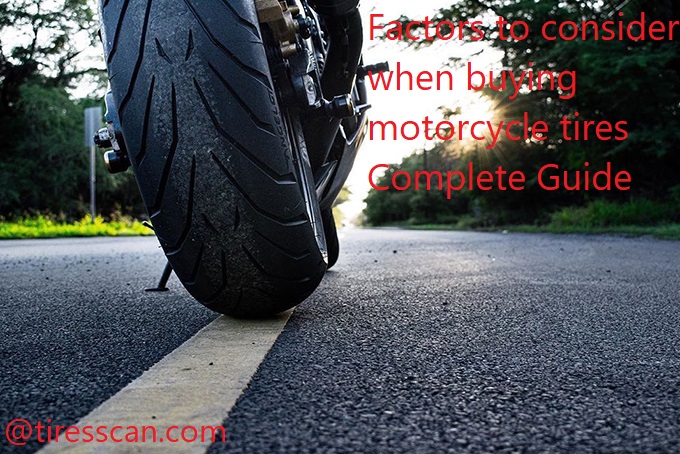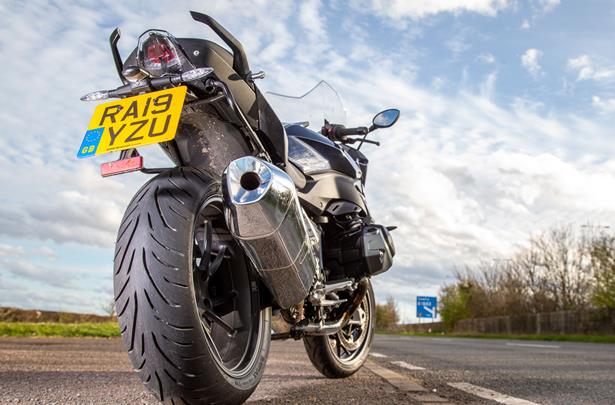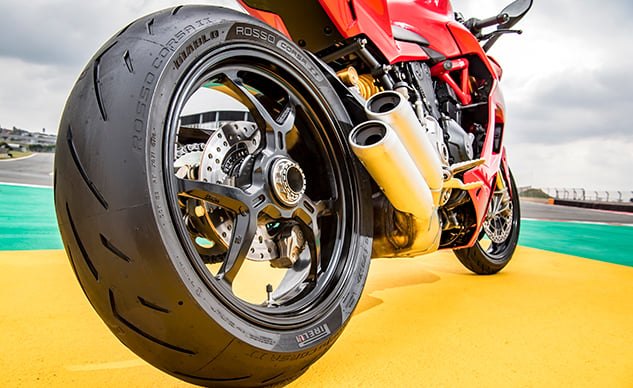Are you looking for the best motorcycle tires to buy? With so many options available in the market, it can often be difficult to decide which ones are suitable for your bike and fit your budget.
This guide will help you make an informed decision by outlining key factors to consider when selecting motorcycle tires. You’ll learn everything from tire sizes to warranties, helping you make the right choice for your ride!
Motorcycle tires provide the important link between the road and your motorcycle, transferring your throttle control to the pavement. Whether you want performance, power or reliability – choosing the right motorcycle tires is essential to safe and fun riding. But, with hundreds of companies all claiming to be best in quality, how do you choose the right tire specifically for your bike?
This guide will provide a detailed overview on factors to consider when buying motorcycle tires for your motorcycle; from size, tread patterns and profiles to weather-specific tires. At the end of this read, you should be confident enough to buy tires that match both your motorcycling needs and budget! Let’s get into it!
Tread Pattern
The tread pattern determines how the tire will perform in different conditions, so it’s important to choose one that will be suitable for your needs. Generally speaking, the more tread pattern a tire has, the better grip it will provide. For example, tires designed for off-road riding feature large and heavily-grooved patterns that help provide extra grip on dirt and mud surfaces. Street tires, on the other hand, feature less aggressive tread patterns that are designed to offer good grip while traveling at higher speeds on tarmac and asphalt surfaces.
It’s important to note that some road tires also have small sipes or grooves in their tread blocks; these are specially designed to displace water for added safety when riding in wet weather conditions. It is also worth mentioning that some motorcycle tires are directional – meaning they may only be used when mounted with the arrow icon pointing in the direction of travel. This is another factor you should take into consideration when buying motorcycle tires.

Understanding Tread Patterns
When you’re shopping for motorcycle tires, it’s important to understand some basic principles of tire tread patterns. The right tread pattern can significantly increase the performance of your motorcycle in all types of terrain.
Tread patterns come in three main varieties: rib, block and crossover. Rib tread is made up of continuous curved ribs which help reduce water build-up and provide superior grip in wet conditions. This kind of tire is ideal for normal road use and handles both dry and wet roads effectively. Block treads are great for off-road rides and for more aggressive use on asphalt surfaces. They offer good grip in off-road conditions due to their increased contact surface area with the ground, getting more traction for faster acceleration, superior handling, braking power, and cornering abilities. A crossover pattern combines the advantages of ribs and blocks by offering a combination tread design with smaller grooves which provide better handling on dry surfaces while larger grooves help push away mud from the knobs to ensure maximum grip when cornering or accelerating on wet or slippery terrain.
No matter what type of tire you choose, make sure it meets the specified requirements outlined in the owner’s manual or any other guidelines provided by manufacturers that are crucial to your safety. When choosing a specific model, be sure to consider its load rating (the amount of weight your bike can carry), speed rating (the maximum speed calculations using laboratory tests) as well as its size juxtaposed against available options compatible with your motorcycle’s wheel size.
Factors Affecting Tread Wear
Tread wear is a critical factor when buying motorcycle tires and there are several key elements that affect the rate at which its treads will wear down. These include tire type, road surface, ride loading and suspension settings.
Tire Type: Different types of tires have different ratings for tread wear. Sports bike tires are designed to provide maximum traction and grip at high speeds, providing excellent cornering and braking ability, however these tires are typically made from softer rubber compounds that also contribute to faster tread wear. Touring/Cruiser bike tires on the other hand offer slightly less grip but have a longer lasting tread life due to their harder rubber compound construction.
Road Surface: Smooth roads contribute very little to the wearing of motorcycle tire treads whereas rough roads cause rapid loss of the grooves in the tire leading to an increase in hydroplaning risk as well as decreased traction and braking ability in wet or icy conditions. Grooved roads further add to this problem. It is important to choose a tire type according to your specific terrain needs as well as budget restraints if you want your motorcycle tires to last long before replacement is needed.
Ride Loading & Suspension Settings: An overloaded bike can cause excessive strain on rear suspension set up hence resulting in faster wearing out of treads on both front and rear wheels. Unbalanced weight distribution can cause premature wear particularly on the drive side due to additional stress caused by changing direction while cornering or while slowing down or accelerating suddenly. Therefore it is important to ensure your suspension settings match your riding style as well as make sure that your vehicle isn’t overloaded with unnecessarily weight items if you want your tires’ treads last long before replacing them again with new ones.
Size and Fitment
When it comes to choosing the right motorcycle tires for your bike, there are a few important factors to consider. One of the most important is size and fitment. Selecting the wrong size tire will not only lead to an uncomfortable ride but can also be dangerous, as the wrong tires can lead to traction and/or stability problems.
Before purchasing new tires, check your bike’s owner’s manual or its tire placard, normally located on the gas tank or inside a side panel. The manual will provide exact tire sizes and pressures while the placard typically lists only general tire sizes that feature a wider range of widths and ratios than those recommended by your manufacturer.
The most common measurements found on a motorcycle tire are its rim diameter, width, aspect ratio (profile height), capacity load index and speed rating (speedsymbol). All these measurements should be taken into account when selecting a new set of tires for your motorcycle. Some manufacturers also include load ratings that indicate how much weight each tire can bear as well as grooves/thread patterns designed for proper water dispersion in wet conditions. Be sure to read all labels carefully before you purchase!
Importance of Choosing the Right Size
When it comes to choosing motorcycle tires, size matters. It’s important to use the correct tire diameter, width and profile for your motorcycle. Your tire size will influence your handling characteristics, and incorrect sizing can affect the stability, performance and maneuverability of your ride.
Tire diameters represent how tall a tire is when fully inflated and is usually expressed as ATD (actual tread diameter). Tire profile is generally expressed as an aspect ratio between the sidewalls of a tire. A “50-series” tire indicates a sidewall height that is 50% of its width. Meanwhile, the load index represents a load rating code assigned to tires designating their capability in carrying specific amounts of loads under defined conditions. Knowing these critical measurements helps you ensure that you get exactly what you need for safe operations on the road and off-road track.
Common Mistakes to Avoid
In most cases, you don’t want to skimp on buying your motorcycle tires. While it is important to save money by making sure that you buy from a reliable supplier, you also want to ensure that you get the best possible quality for your money. Unfortunately, there are a few common mistakes that people make when buying motorcycle tires, so here is a brief guide on what NOT to do when shopping for new tires:
- Don’t be too fixated on price alone – it may be tempting to go with the cheapest option but bear in mind that more expensive options will generally provide better performance and last longer
- Don’t ignore manufacturer recommendations – while these can vary based on style of bike, they often provide good guidance as to what size and tread types are suitable for your bike so it pays to at least look at their recommendations
- Don’t just pick randomly – do some research into the different tire types available and try to match them up with your riding style and needs; certain tires are better suited for certain riding conditions than others.
- Don’t forget about safety – regardless of how much you paid or which brand you chose, it’s always important that the tires you choose comply with relevant safety standards and have been tested thoroughly
- Lastly, don’t forget about proper tyre maintenance – tyres need regular checks for wear and tear as well as inflation levels in order to ensure maximum performance over time

Construction
- Construction — Motorcycle tires are constructed with two basic designs; bias-ply and radial. In a bias-ply construction, the cords that form the body of the tire run diagonally across the tread in alternating layers or plies placed at an angle, usually 30 to 40 degrees apart.These are constructed using nylon or polyester cords embedded in rubber and layered at an angle which increases the cornering capability of a tire.
In a radial construction, the cord plies run perpendicular to the direction you ride and are separated by a layer of rubberized material known as belts that enhance handling and cornering performance by maintaining more consistent contact with the road surface under a wide range of operating conditions. Radial tires provide better wear characteristics than bias-ply tires, which means they will offer longer life than their counterpart in most cases.
Bias-Ply Tires
Bias-ply tires are those constructed of two or more fabric plies that cross each other at angles. Each ply is typically separated from the adjacent ply by a cord of rubber. This type of construction offers superior traction, superior ride comfort and a longer life expectancy than radial tires. Bias-ply tires are an excellent choice for heavier loaded or touring motorcycles, or in any application when longer mileage is desired and heavier load carrying capability needed. The most distinctive feature of bias-ply tires is that they have a slightly higher ride height than equivalent radial tires.
When shopping for motorcycle tires there are specific factors to consider when buying bias-ply tires, such as tire size, load rating and speed rating. When checking your motorcycle’s current tire size look for the numbers printed in the sidewall that indicate load and speed ratings. When comparing tire sizes make sure you find the correct ratings for your bike’s operating conditions and riding style.
Radial Tires
Radial tires are commonly accepted as the predominant tire type in modern times due to their improved performance over bias-ply tires. Radials offer greater strength, flexibility, and stability on the road. They are constructed of steel mesh bands with rubber compounds between them and around them. This allows the tire to flex more evenly and increases its life span. The steel belts are generally arranged radially outwards from bead to bead (thus the name).
Radial bike tires are generally preferred for street riding, touring, cruiser motorcycles, or any bike taking extended trips with heavy loads. They provide 3 major benefits:
- Longer tire life—they have increased tread-life due to better protection against heat damage caused by flexing on corners;
- Better ride comfort—they reduce vibrations caused by uneven tread-wear due to cornering:
- Better grip—the rubber compounds used in radial tires provide better traction and grip on wet roads compared to bias ply tires;
Belted Tires
Belted tires are designed for excellent grip, maximum wear resistance and superior handling. They are composed of two CAP plies, in which the cords are reinforced with a belt of material that runs around the circumference of the tire, sandwiched between inner and outer plies. Belted tires give better stability and wear less easily compared to bias-ply models due to their ability to resist centrifugal force or lateral skidding. They also feature an increased load index rating but still offer good steering response, making them ideal for riders who prefer performance-oriented riding over longer periods.
Belted tires are often recommended as high mileage replacements on heavier bikes and larger displacement motorbikes or dual sport motorcycles because they give greater stability when accelerating, braking and cornering.

Conclusion
In conclusion, there are a number of factors to consider when selecting the right motorcycle tires for your bike. It is important to take into account the type of road surface you will be riding on, as well as the amount of power your bike has and how much weight it carries. Additionally, you should pay attention to the type of tread pattern and tire compound that are best suited for your riding style and personal preference.
When in doubt, it is always best to consult an experienced professional at a tire shop before making any final decisions. With these considerations in mind, your motorcycle will be ready for whatever roads life may take you on!
FAQs
How do I choose the right motorcycle tire?
You should consider factors like tire size, type of riding, weather conditions, load capacity, and brand reputation. It’s also essential to select a tire that’s compatible with your motorcycle’s specifications.
What does 72h mean on a motorcycle tire?
72h indicates that the tire can withstand a speed of up to 210 km/h (130 mph) for a duration of 72 hours without sustaining any damage or failure.
What is the average life of motorcycle tires?
The average lifespan of motorcycle tires is around 5,000 to 15,000 miles, depending on factors like riding style, road conditions, and maintenance.
What does 80 80 17 tire mean?
80 80 17 refers to the tire’s size, where 80 represents the width of the tire in millimeters, 80 denotes the aspect ratio (height-to-width ratio) of the tire, and 17 indicates the diameter of the wheel in inches.
Which tire wears out first on a motorcycle?
The rear tire tends to wear out faster than the front tire because it carries more weight and is responsible for providing propulsion.
What is B vs R on motorcycle tire?
B and R refer to the tire’s construction type. B stands for Belted Bias-Ply, where the tire has a belt layer to improve stability and durability. R represents Radial, where the tire has a radial ply design for better handling and cornering.
Which is better 4 ply or 6 ply motorcycle tires?
6-ply motorcycle tires are generally more durable and have a higher load-carrying capacity than 4-ply tires. However, the choice between them depends on your motorcycle’s specifications and intended use.
What does the V stand for on motorcycle tires?
The V denotes the tire’s speed rating, where it can handle speeds up to 240 km/h (149 mph).
What does MC mean on a motorcycle tire?
MC indicates that the tire is designed for use on motorcycles.
What’s the best motorcycle tires for street?
The best motorcycle tires for street use depend on your riding style, the type of motorcycle you have, and the road conditions. Some of the top brands for street use include Michelin, Bridgestone, Pirelli, and Dunlop. It’s important to choose a tire that fits your specific needs and preferences.
See Also:
- Best tires for honda crv
- Best Tires For Corvette C6
- Best Tires for Honda Civic
- Best Tires for Honda Accord
- Best Tires For Chevy Equinox

